Article Title(記事タイトル):
Healthy and Delicious! Various Types of Sushi in Japan
ヘルシーでおいしい!いろいろな種類の日本の寿司
Contributor(投稿者):
Luka(るか)
Country of residence(在籍国):
Japan(日本)
Comment(コメント):
Nice to meet you! My name is Luka. I live in Chiba (next to Tokyo) in Japan. Chiba is famous for its fish, meat ,vegetables and fruit.I love a good meal! I’m learning English, so I tried writing this article in English. I hope you enjoy reading it!
はじめまして!るかです。私は日本の千葉に住んでいます。千葉は魚、肉、野菜や果物で有名です。私はおいしいものが大好きです!私は英語を勉強しているので、この記事を英語で書いてみました。これを読んで楽しんでいただけると嬉しいです!
When it comes to Japanese food, what do you think of?
Do you think of sushi, sukiyaki, tempura, ramen and shabushabu?
Sushi is one of the most popular Japanese food all over the world.
日本の食べ物と言えば、何を思い浮かべますか?
寿司、すきやき、てんぷら、ラーメンやしゃぶしゃぶを思い浮かべるでしょうか?
寿司は世界中で一番人気のある日本食のひとつです。
I remember I had a great time celebrating the New Year with my family and my relatives enjoying sushi together as a child.
This time, I wrote about various types of sushi in Japan!
私は子どものころ、家族や親せきといっしょに寿司を食べながら、新年をお祝いしたことを思い出します。
今回は、いろいろな種類の日本の寿司について書いてみました!
Nigiri-zushi (Hand-formed Sushi) にぎり寿司
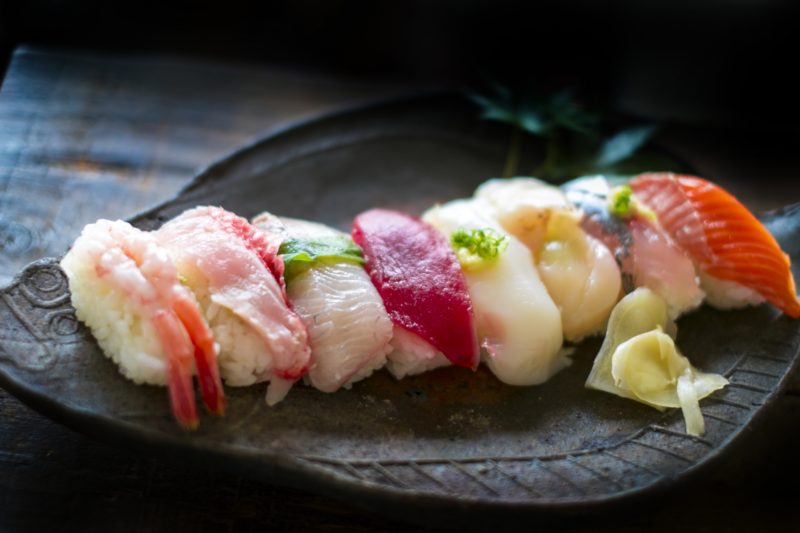
There are two main types of sushi in Japan, “Nare-zushi”(aged sushi) and “Haya-zushi”(fast sushi).
“Nare-zushi” has been around since the 8th century AD in Japan, and is made with fish racto-fermented with cooked rice and salt.
日本の寿司は、「なれ寿司」と「早寿司」の主に2つのタイプがあります。
「なれ寿司」は紀元8世紀ごろから日本にあり、ご飯と塩で乳酸発酵させたものです。
“Haya-zushi”, also known “edomae-zushi”(edo-style sushi), is made with vinegared rice and seafood.
It was popular food served at street stalls in the Edo period, which was two or three times larger than today’s “nigiri-zushi”.
Toppiing of “Haya-zushi” was seasoned with soy source, vinegare and “konbu”(kelp).
「早寿司」は、「江戸前寿司」としても知られていて、酢飯と魚介類で作られています。
それは江戸時代に屋台で出されていた人気の食べ物で、今の「にぎり寿司」の2、3倍の大きさでした。
「早寿司」のネタはしょうゆ、酢、昆布で味付けされていました。
“Nigiri-zushi” is one of the “haya-zushi”, is a small cylinder-shaped rice ball placed toppings on it with “wasabi”(Japanese horseradish) paste.
You can find it everywhere in Japan, from cheap conveyor-belt sushi restaurants to high-class sushi restaurants.
Here are some of the popular “nigiri-zushi” in Japan!
「にぎり寿司」は「早寿司」のひとつで、小さな俵型のご飯の上に「わさび」といっしょにネタが乗っています。
「にぎり寿司」は、安い回転寿司屋から高級な寿司屋まで、日本中どこにでもあります。
日本で人気のある「にぎり寿司」をいくつかご紹介します!
Maguro(Akami) (Lean Meat of Tuna) マグロ(赤身)
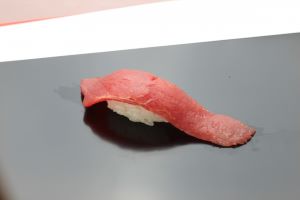
Winter is the best season for wild tuna.
“Maguro(Akami)” is a part of body with little fat and has a strong and refreshing flavor.
During the “Edo” period, people used to marinate lean meat of tuna in soy source,“sake”(Japanese rice wine),“mirin”(sweet rice wine with a lower alcohol content than sake) to preserve it.
天然のマグロの旬は冬です。
「マグロ(赤身)」は脂身の少ない部位で濃厚でさっぱりとした味です。
江戸時代には、人々はよく、マグロの赤身を保存するために、しょうゆ、「酒」、「みりん」に漬けていました。
Chutoro (Medium-Fatty Tuna) 中トロ
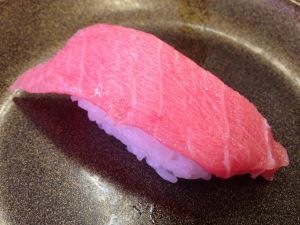
“Chutoro” is taken from belly and back of the tuna.
It has a low acidity and a good balance of flavor and sweetness from the lean meat and fat.
“Toro” means melt in Japanese.
「中トロ」はマグロのお腹と背中から取ります。
酸味が少なく、赤身と脂身からのうま味と甘さがバランスよくあります。
「トロ」とは日本語でとけるという意味です。
Otoro (Fatty Tuna)大トロ
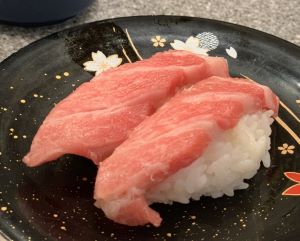
“O-toro” is a soft fatty part of tuna with a rich flavor and a-melt-in-your-mouth texture.
Although it is one of the most popular topping today, it was discarded during the “Edo” period because it was easily rotten and fatty.
I know, it’s hard to believe, isn’t it?
「大トロ」は、濃厚なうま味と口の中でとろけるような食感のあるやわらかいマグロの脂身の部位です。
今日では最も人気のあるネタのひとつですが、江戸時代では傷みやすく脂が多いという理由で捨てられていました。
信じられないですよね?
Katuo (Bonito)カツオ
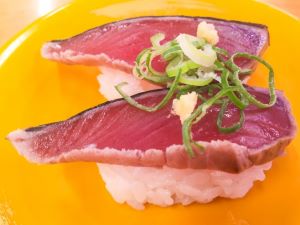
“Hatsu-gatsuo”(bonito caught in spring) has a refreshing sour taste and “Modori-gatsuo”(bonito caught in autumn) has a strong sweetness from its fat.
“Katsuo” is often served with green onions, grated ginger, grated garlic and citrus fruits.
“Katsuo-no-tataki” made from seared bonito is also delicious.
「初ガツオ」はさっぱりとした酸味のある味で、「戻りガツオ」は脂身からの濃い甘みがあります。
「カツオ」はよく、ネギ、おろししょうが、おろしニンニク、柑橘類といっしょに出されます。
炙ったカツオで作られる「カツオのたたき」もおいしいです。
Kajiki (Swordfish) カジキ
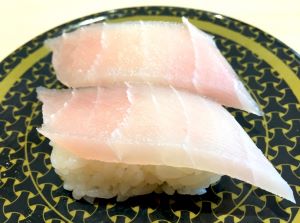
Summer is the best season for “kajiki”.
“Kajiki” is often called “kajiki-maguro(swordish tuna)” because it is similar to tuna in texture and color, but it is a different fish from tuna.
カジキの旬は夏です。
「カジキ」は、食感と色がマグロと似ているので、よく「カジキマグロ」と呼ばれますが、マグロとは違う魚です。
Sake (Salmon) サケ

Japanese “sake (shake)” is in season from late summer to autumn.
Although “sake” is not a traditional topping, it is one of the most popular options all over the world today.
It is popular for its creamy and mild flavor.
日本の「サケ」の旬は晩夏から秋です。
「サケ」は伝統的なネタではありませんが、今では世界中で最も人気のあるネタのひとつです。
クリーミーでまろやかな味で人気があります。
Buri, Hamachi ( Yellowtail, Young Yellowtail) ブリ、ハマチ
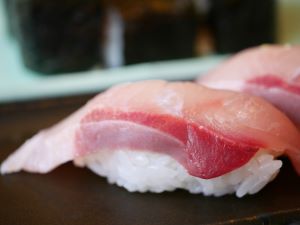
Winter is the best season for “buri” and “hamachi”.
“Buri” and “hamachi” are same fish and have a sweet taste and a rich flavore.
“Buri” changes its name as it grows larger.
These fish are called “shusse-uo”(fish that are promoted) in Japanese.
「ブリ」と「ハマチ」の旬は冬です。
「ブリ」と「ハマチ」は同じ魚で、甘みがあり、濃厚な味です。
「ブリ」は成長するにつれて名前が変わります。
このような魚は日本語で「出世魚」と呼ばれます。
Tai (Sea Bream) タイ

Spring and autumn are the best season for “Tai”.
“Tai” caught in spring is called “sakura-dai”(cherry blossom sea bream) and the one caught in autumn is called “momiji-dai”(red leaves sea breams).
“Tai” is often served for celebrations.
It has a nice crunch, and has an elegant “umami” taste and sweetness that comes later.
「タイ」の旬は春と秋です。
春にとれる「タイ」は「さくらダイ」と呼ばれ、秋にとれるものは「もみじダイ」と呼ばれます。
「タイ」はお祝いによく出されます。
ほどよい歯ごたえがあり、後からくる上品な「うま味」と甘みがあります。
Hirame (Flounder)ヒラメ
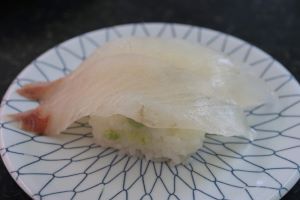
Winter is the best season for “Hirame”.
It has a nice crunch and an elegant falvor.
The muscular part near the fin, called “en-gawa”, is very popular for its crunch and sweet taste.
「ヒラメ」の旬は冬です。
歯ごたえがあり、上品な味です。
えらに近い筋肉部位は、「えんがわ」と呼ばれ、そのコリコリした食感と甘みでとても人気があります。
Kanpachi(Amberjack) カンパチ
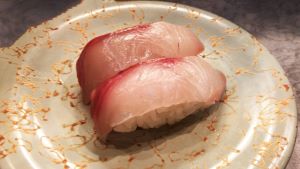
Summer is the best season for “Kanpachi”.
It has a mild flavor of fatty meat.
“Kanpachi” is similar to yellowtail, but they are different fish.
「カンパチ」の旬は夏です。
脂身からの甘みがあります。
「カンパチ」はブリと似ていますが、違う魚です。
Kohada (Gizzard Shad)コハダ

Winter is the best season for “Kohada”.
Vinegar and salt give it the perfect “umami” flavor.
“Kohada” is a small fish and difficult to season, so it is said that the skill of a sushi chef can be judged by the taste of it.
「コハダ」の旬は冬です。
酢と塩により完ぺきな「うま味」が出ます。
「コハダ」は小さい魚で、味付けするのが難しいので、「コハダ」の味で寿司職人の腕がわかると言われています。
Sanma (Pacific Saury)サンマ

Autumn is the best season for “sanma”.
Raw “sanma” sushi with green onions and grated ginger, and seared “sanma” sushi are also available.
「サンマ」の旬は秋です。
ネギとおろししょうがと出される生の「サンマ」寿司や、炙った「サンマ」寿司もあります。
Aji (Jack Mackerel) アジ

“Aji” is in season from spring to autumn.
It is served with green onions and grated ginger as a condiment.
It is also delicious with “wasabi”(Japanese horseradish) and “shiso”(Japanese herb).
「アジ」の旬は春から秋です。
薬味のネギやおろししょうがといっしょに出されます。
「わさび」と「しそ」といっしょでもおいしいです。
Anago (Conger Eel) アナゴ
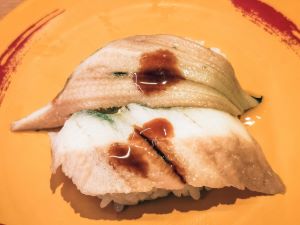
Summer is the best season for “anago”.
Its shape is similar to that of eels, but its taste is less oily.
It has been popular since the Edo period.
It is opened in the back and simmered in water, “konbu”(kelp), sugar, soy source, “mirin”(sweet Japanese wine) and “sake”(Japanese wine) in Kanto area, and it is grilled in a sweet soy source in Kansai area.
「アナゴ」の旬は夏です。
かたちはウナギに似ていますが、ウナギよりも脂っぽくありません。
江戸時代から人気があります。
関東地方では、「アナゴ」は背開きにして、水、「こんぶ」、砂糖、しょうゆ、「みりん」、「酒」で煮ますが、関西地方では甘辛いたれで焼きます。
Tako (Octopus) タコ
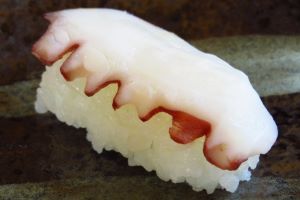
“Tako”is in season from spring to summer.
It is juicy and tasty as you chew it.
「タコ」の旬は春から夏です。
みずみずしく嚙むごとに味わいがあります。
Ika (Squid) イカ
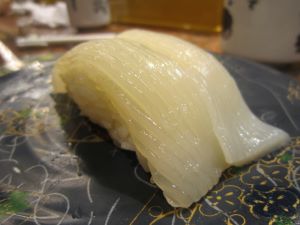
Each type of “ika” has a differnt season.
“Ika” sushi was cooked in water, sugar and soy source and served in the Edo period.
「イカ」の種類ごとに旬が違います。
江戸時代では、「イカ」の寿司は、水、砂糖、しょうゆで調理されて出されていました。
Hotate (Scallop) ホタテ
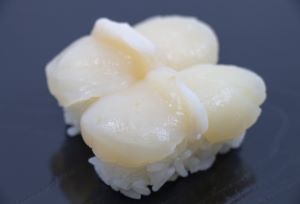
Many of “hotate” are farmed, so they can be served all year round.
It has a soft texture and a sweet taste.
多くの「ホタテ」は養殖されているので、一年中あります。
やわらかい食感と甘みがあります。
Tamago-yaki (Omelet) 玉子焼き
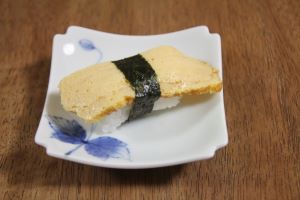
“Tamago-yaki” is said to have originated from “kasutera”(the Netherlands’ sponge cakes) that were popular in Edo.
Each sushi restaurant has its own unique taste for “tamago-yaki”.
「玉子焼き」は、江戸時代に人気があった「かすてら」がはじまりと言われています。
寿司屋には、それぞれ独自の「玉子焼き」の味があります。
Kuruma-ebi (Japanese Tiger Prawn) クルマエビ

Wild “kuruma-ebi” is in season in winter and farmed one is in season in summer.
It is one of the traditional “nigiri-zushi”, and is called the king of sushi topping.
天然の「クルマエビ」の旬は冬で、養殖もの旬は夏です。
伝統的な「にぎり寿司」のひとつで、寿司ネタの王様と呼ばれています。
Ama-ebi (Sweet Shrimp) アマエビ
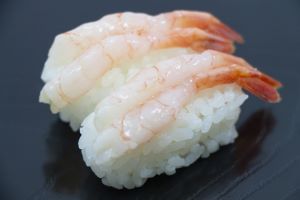
“Amaebi” is in season from autumn to winter.
It has a soft meat and a sweet taste.
「アマエビ」の旬は秋から冬です。
やわらかい身で、甘みがあります。
Various Other Japanese Sushi その他のいろいろな日本の寿司
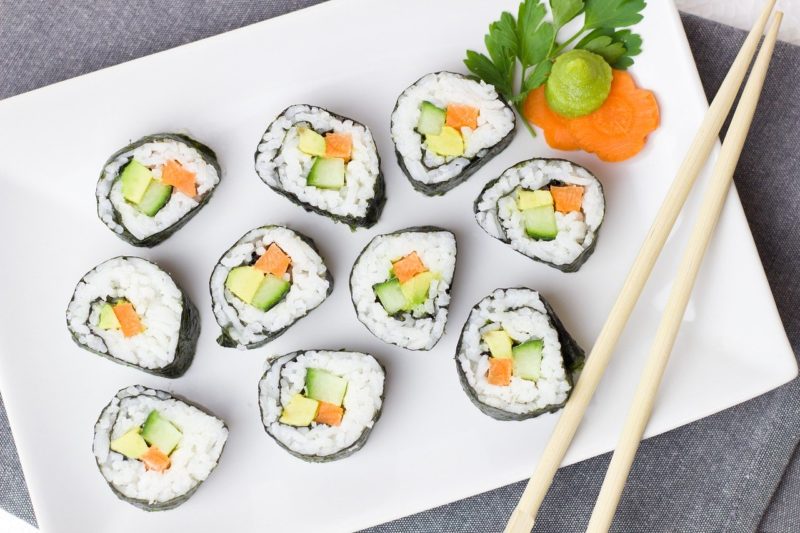
There are many other kinds of sushi besides “nigiri-zushi” in Japan.
Then I’d like to introduce other 5 types of sushi!
日本には「にぎり寿司」の他にもたくさんの種類の寿司があります。
そこで、その他の5つのタイプの寿司をご紹介します!
Gunkan-maki (Battleship Rolls) 軍艦巻き

“Gunkan-makii”, a type of “haya-zushi”(fast sushi), is made with a small cylinder-shaped rice ball placed fish roe and seasoned vegetables on it.
The sides of it are wrapped with “nori”(dried laver seaweed).
Typical toppings of “gunkan-maki” are “ikura”(salmon roe), “uni”(sea urchin), “negi-toro”(a lean meat of tuna minsed with green onions), “kani-miso”(crab innards) and so on.
「軍艦巻き」は「早寿司」のひとつで、ご飯を小さい俵型にしたもので作られ、その上に魚卵や野菜のあえものがのっています。側面が「海苔」で包まれています。
軍艦巻きの代表的なネタは、「いくら」、「うに」、「ねぎとろ」、「かにみそ」などです。
Maki-mono (Sushi Rolls) 巻もの
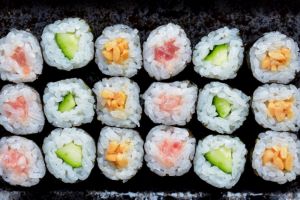

“Maki-mono”, a type of fast sushi, are usually made with vinegared rice, fish, omelet, veggetables and a “nori”(dried laver seaweed) sheet.
In Kanto area, it is called “nori-maki” and there are three kinds of rolls: thin, medium and thick.
In Kansai area, it is called “maki-zushi” and usually refers to a thick roll.
「巻もの」は、早寿司のひとつで、酢飯、魚、玉子焼き、野菜や海苔で作られます。
関東地方では、「海苔巻き」と呼ばれ、細巻き、中巻き、太巻きの3種類があります。
関西地方では、「巻き寿司」と呼ばれ、太巻きのことを指します。
Typical Ingredients of “maki-mono” are fish, cucumber, “natto”(fermented soybeans), “kanpyo”(dried gourd shavings), “tamago-yaki”(seasoned omelet) and so on.
「巻もの」の代表的な材料は、マグロ、きゅうり、「納豆」、「かんぴょう」、玉子焼きなどです。
Sometimes a sheet of “tamago-yaki”(seasoned omelet) is used instead of a sheet of “nori”(dried laver seaweed).
There are also “soba-zushi”(buckwheat noodles sushi) and “okara-zushi”(soy pulp sushi).
“Temaki-zushi”(hand-rolled sushi) is also popular in Japan, but it is usually home-style sushi.
「海苔」のかわりに「玉子焼き」を使ったものもあります。
「そば寿司」や「おから寿司」もあります。
「手巻き寿司」も日本では人気がありますが、たいてい家庭料理です。
Chirashi-zushi (Scattered Sushi) ちらし寿司

“Chirashi-zushi”, a type of fast sushi, is served on bowls or plates with many toppings(seafood, vegetables, seasoned omelet and other ingredients) scattered on vinegared rice.
「ちらし寿司」は、早寿司の一種で、酢飯の上に散らされたたくさんのネタ(魚介類、野菜、玉子焼きやその他の具材)といっしょにどんぶりやお皿で出されます。
Inari-zushi (Sushi Wrap) いなり寿司

“Inari-zushi”, a type of fast sushi, is a cylinder-shaped vinegared rice ball wrapped in “abura-age”(a deep-fried soybean curd).
“Abura-age”, used for “inari-zushi”, is simmered with soy source, sugar,”mirin”(Japanese sweet wine), sake(Japanese wine).
Sometimes vinegared rice is mixed with cooked carrots and dried Japanese mashrooms which are chopped into small pieces.
「いなり寿司」は、早寿司の一種で、酢飯を俵型にして「油揚げ」で包んだものです。「いなり寿司」に使われる「油揚げ」は、しょうゆ、砂糖、「みりん」、「酒」で煮てあります。
酢飯に、みじん切りにして調理された人参やしいたけを混ぜることもあります。
Hako-zushi (Box-Pressed Sushi) 箱寿司
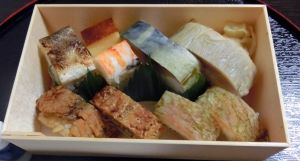
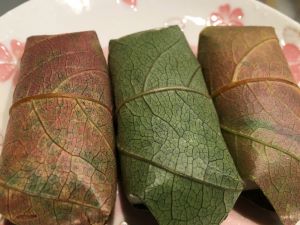
“Hako-zushi”, a traditional type of “nare-zushi(aged sushi)” in Kansai area,
It is vinegared rice stuffed into a square wooden frame, topped with ingredients such as sea bream, conger eel, shrimp and so on.
There are two types of “hako-zushi”: “oshi-zushi”(pressed sushi) and “bo-zushi”(pressed and rolled sushi stick).
「箱寿司」は、関西地方の伝統的な「なれ寿司」のひとつです。
四角い木の枠に詰められており、タイ、アナゴ、エビなどの具材が上にのっています。
「箱寿司」には、「押し寿司」と「棒寿司」の2つのタイプがあります。
“Battera”(vinegared mackerel sushi), a type of “oshi-zushi”, is famous in Osaka.
“Saba-zushi”(vinegared mackerel sushi), a type of “bo-zushi”(pressed and rolled sushi stick), is famous in Kyoto.
“Kakinoha-zushi”(salted mackerel sushi) of Nara, a type of “oshi-zushi”, is wrapped with persimmon leaves.
大阪は「押し寿司」の一種「バッテラ」で有名です。
京都は「棒寿司」の一種「さば寿司」で有名です。
奈良の「柿の葉寿司」は、「押し寿司」の一種で、柿の葉で包まれています。
Enjoy Your Favorite Sushi in Japan ! 日本の寿司をお楽しみください!
The various types of Japanese sushi in this article are as follows.
この記事のいろいろな種類の日本の寿司は下記の通りです。
- Nigiri-zushi (Hand-formed Sushi) にぎり寿司
- Gunkan-maki (Battle Ship Rolls) 軍艦巻き
- Maki-mono (Sushi Rolls) 巻きもの
- Chirashi-zushi (Scattered Sushi) ちらし寿司
- Inari-zushi (Sushi Wrap) いなり寿司
- Hako-zushi (Box-Pressed Sushi) 箱寿司
There’s too much healthy and delicious sushi in Japan to introduce all of them.
If you have a chance to come to Japan, I recommend you to enjoy your favorite Japanese sushi!
Thank you for reading to the end!
日本にはヘルシーでおいしい寿司がたくさんあって、紹介しきれません。
もし日本に来る機会があれば、あなたのお気に入りの日本の寿司を楽しんでください!
最後までお読みいただき、ありがとうございました!









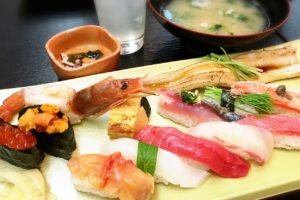



コメントを残す